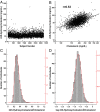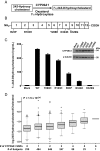Genetic, anatomic, and clinical determinants of human serum sterol and vitamin D levels
- PMID: 25201972
- PMCID: PMC4183318
- DOI: 10.1073/pnas.1413561111
Genetic, anatomic, and clinical determinants of human serum sterol and vitamin D levels
Abstract
An unknown fraction of the genome participates in the metabolism of sterols and vitamin D, two classes of lipids with diverse physiological and pathophysiological roles. Here, we used mass spectrometry to measure the abundance of >60 sterol and vitamin D derivatives in 3,230 serum samples from a well-phenotyped patient population. Twenty-nine of these lipids were detected in a majority of samples at levels that varied over thousands of fold in different individuals. Pairwise correlations between sterol and vitamin D levels revealed evidence for shared metabolic pathways, additional substrates for known enzymes, and transcriptional regulatory networks. Serum levels of multiple sterols and vitamin D metabolites varied significantly by sex, ethnicity, and age. A genome-wide association study identified 16 loci that were associated with levels of 19 sterols and 25-hydroxylated derivatives of vitamin D (P < 10(-7)). Resequencing, expression analysis, and biochemical experiments focused on one such locus (CYP39A1), revealed multiple loss-of-function alleles with additive effects on serum levels of the oxysterol, 24S-hydroxycholesterol, a substrate of the encoded enzyme. Body mass index, serum lipid levels, and hematocrit were strong phenotypic correlates of interindividual variation in multiple sterols and vitamin D metabolites. We conclude that correlating population-based analytical measurements with genotype and phenotype provides productive insight into human intermediary metabolism.
Keywords: genotype–phenotype correlation; human genetics.
Conflict of interest statement
The authors declare no conflict of interest.
Figures






References
-
- Garcia CK, et al. Autosomal recessive hypercholesterolemia caused by mutations in a putative LDL receptor adaptor protein. Science. 2001;292(5520):1394–1398. - PubMed
-
- Berge KE, et al. Accumulation of dietary cholesterol in sitosterolemia caused by mutations in adjacent ABC transporters. Science. 2000;290(5497):1771–1775. - PubMed
-
- He G, et al. ARH is a modular adaptor protein that interacts with the LDL receptor, clathrin, and AP-2. J Biol Chem. 2002;277(46):44044–44049. - PubMed
Publication types
MeSH terms
Substances
Grants and funding
LinkOut - more resources
Full Text Sources
Other Literature Sources
Medical
Molecular Biology Databases

